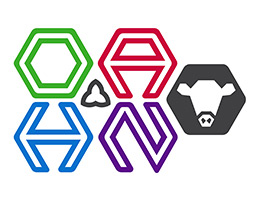Ontario Animal Health Network (OAHN) Bovine Expert Network Quarterly Producer Report
Global Surveillance Update:
Influenza A (H5N1) detected in livestock in the United States of America
Spillover of Influenza A (H5N1) into U.S. livestock was first reported in March 2024 and continues to evolve. Initially a goat kid in Minnesota tested positive for highly pathogenic avian influenza (HPAI) followed by an announcement from USDA that H5N1 had been detected in milk from ill dairy cattle.
The Ontario Animal Health Network will keep their page up to date with new resources as available at: H5N1 Detections In U.S. Livestock 2024 – Ontario Animal Health Network (oahn.ca).
Resources
Updates from the U.S. Department of Agriculture – Animal and Plant Health Inspection Service
- includes updated numbers on confirmed cases of HPAI in U.S livestock, biosecurity guidance, and milk safety documents
Highly Pathogenic Avian Influenza (HPAI) Detections in Livestock | Animal and Plant Health Inspection Service (usda.gov)
Updates from the Canadian Food Inspection Agency (CFIA)
- provides information for producers and veterinarians on the latest Canadian information and guidance, including a description of potential clinical signs
Highly pathogenic avian influenza (HPAI) in livestock – Canadian Food Inspection Agency (canada.ca)
CAHSS biosecurity resources
What to do if you observe livestock with clinical signs consistent with Influenza A (H5N1):
- Producers should report clinical signs or suspected illness to their veterinarian immediately
- Veterinarians should contact their local CFIA animal health office if there is a high degree of suspicion
What to do if you find sick or dead birds or other wildlife on your property:
- Report these findings to the Canadian Wildlife Health Cooperative(CWHC) who may arrange for submission of wildlife for testing
2023 Surveillance Highlights
| Lead Toxicity | In 2023, there were 3 cattle herds with lead toxicity in Ontario. Lead is one of the most common toxins in cattle. Cattle are curious and often indiscriminate feeders which puts them at risk when they encounter novel, discarded materials. Although lead cases are typically sporadic, they tend to happen when cattle are turned out to pastures that contain a lead source; a good reminder to check pasture before giving cattle access. | ||||
| Verminous pneumonia in a beef steer | A postmortem on a poor-doer yearling steer that died suddenly in Southwestern Ontario revealed many lungworms within the bronchioles. Further testing identified the lungworms as Dictyocaulus viviparous. This parasite requires access to pasture for successful transmission in cattle. Heavy burdens of this parasite can result in significant illness, particularly in young animals towards the end of their first grazing season. Producers and veterinarians should consider this risk when developing parasite prevention strategies. | ||||
| Yew toxicity in a cow-calf herd | Three sudden deaths over a 12-hour period in a herd of cattle prompted investigation. A postmortem revealed the presence of Japanese yew plant mixed with twigs and roughage in the rumen of one cow. Exposure to even a small amount of Japanese yew, a common ornamental shrub in North America, is sufficient to cause fatal toxicity due to its cardiotoxic effects. In this case, it was confirmed that shrubs had been trimmed on the property and the trimmings were thrown into the pasture with the cattle. | ||||
| Bovine Viral Diarrhea Testing | Quarter | 1 | 2 | 3 | 4 |
| Number Positive | 1 | 1 | 0 | 6 | |
| Number Tested | 282 | 108 | 96 | 167 | |
Salmonella Dublin Update
Laboratory Data 2023
During 2023, 20 lab diagnostic submissions to the AHL detected Salmonella Dublin on bacterial culture or PCR test (Figure 1) plus an additional 12 research submissions. The submissions are estimated to represent 16 separate on farm outbreaks of disease from 14 different farms. For 9 farms, this was their first diagnosis of S. Dublin (Figure 2). This compares to 23 outbreaks and 13 first premises diagnoses in 2022.
As of December 31, 2023, there are estimated to be 100 unique premises in the laboratory dataset that have had S. Dublin, of which 38 are veal, 55 are dairy, and 7 are from a beef operation.
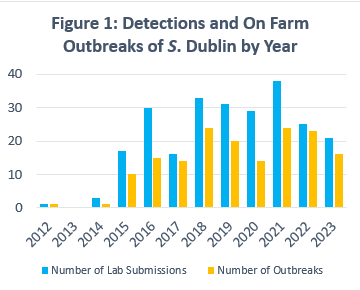
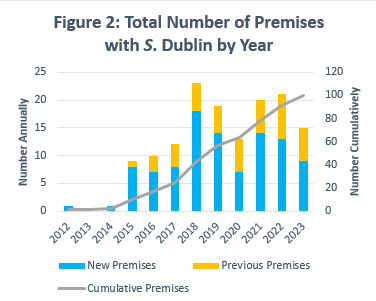
S. Dublin Journal Articles of Interest:
- Risk Factors for Salmonella Dublin on dairy farms in Ontario, Canada https://pubmed.ncbi.nlm.nih.gov/37641251/
- Review: Salmonella Dublin in dairy cattle https://pubmed.ncbi.nlm.nih.gov/38264470/
- Accuracy of testing strategies using antibody-ELISA tests on repeated bulk tank milk samples and/or sera of individual animals for predicting herd status for Salmonella dublin in dairy cattle https://pubmed.ncbi.nlm.nih.gov/37890216/
OAHN Mastitis Report
2023 Mastitis PCR Test Data for Ontario Lactanet Herds
Summary provided by Dr. David Kelton, OVC in collaboration with Lactanet
| 2023 Ontario Mastitis PCR Summary | Number of Samples | Percent of Samples | Group Avg SCC (x1000) |
| Staph aureus POS | 1191 | 12.0% | 1234 |
| S aureus HIGH POS | 116 | 9.740% | 3147 |
| S aureus MOD POS | 487 | 40.89% | 1528 |
| S aureus LOW POS | 588 | 49.37% | 608 |
| Strep ag POS | 6 | 0.06% | 575 |
| Mycoplasma POS | 13 | 0.13% | 3409 |
| Prototheca POS | 162 | 1.63% | 1143 |
| NEG to all 4 pathogens | 8571 | 86.32% | 1063 |
| Total | 9929 | 1088 |
Interpretation Notes
- While 12% of samples were positive for Staph aureus, less than 10% were HIGH positive
- For Staph aureus cows, SCC is correlated with PCR result, as expected
- Caution: Low positive Staph aureus tests might not be infected – check SCC
- Only 6 samples positive for Strep agalactiae
Mastitis Pathogens from Milk Cultures Submitted to the Animal Health Laboratory in 2023 (using MALDI-TOF)
Summary provided by Dr. Tanya Rossi and Dr. Durda Slavic
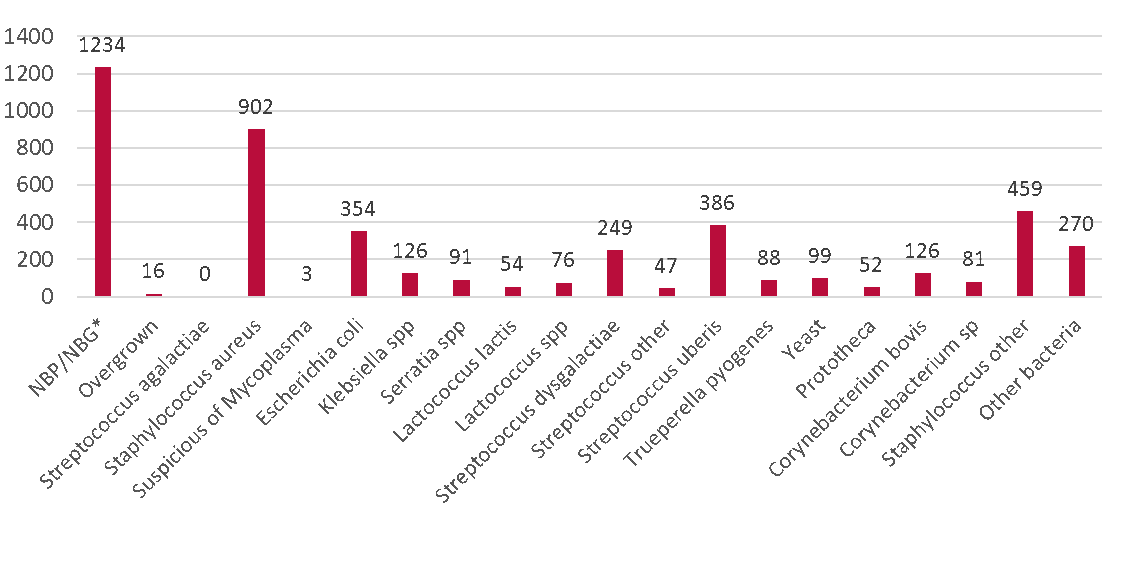
Ontario Bovine Disease Surveillance
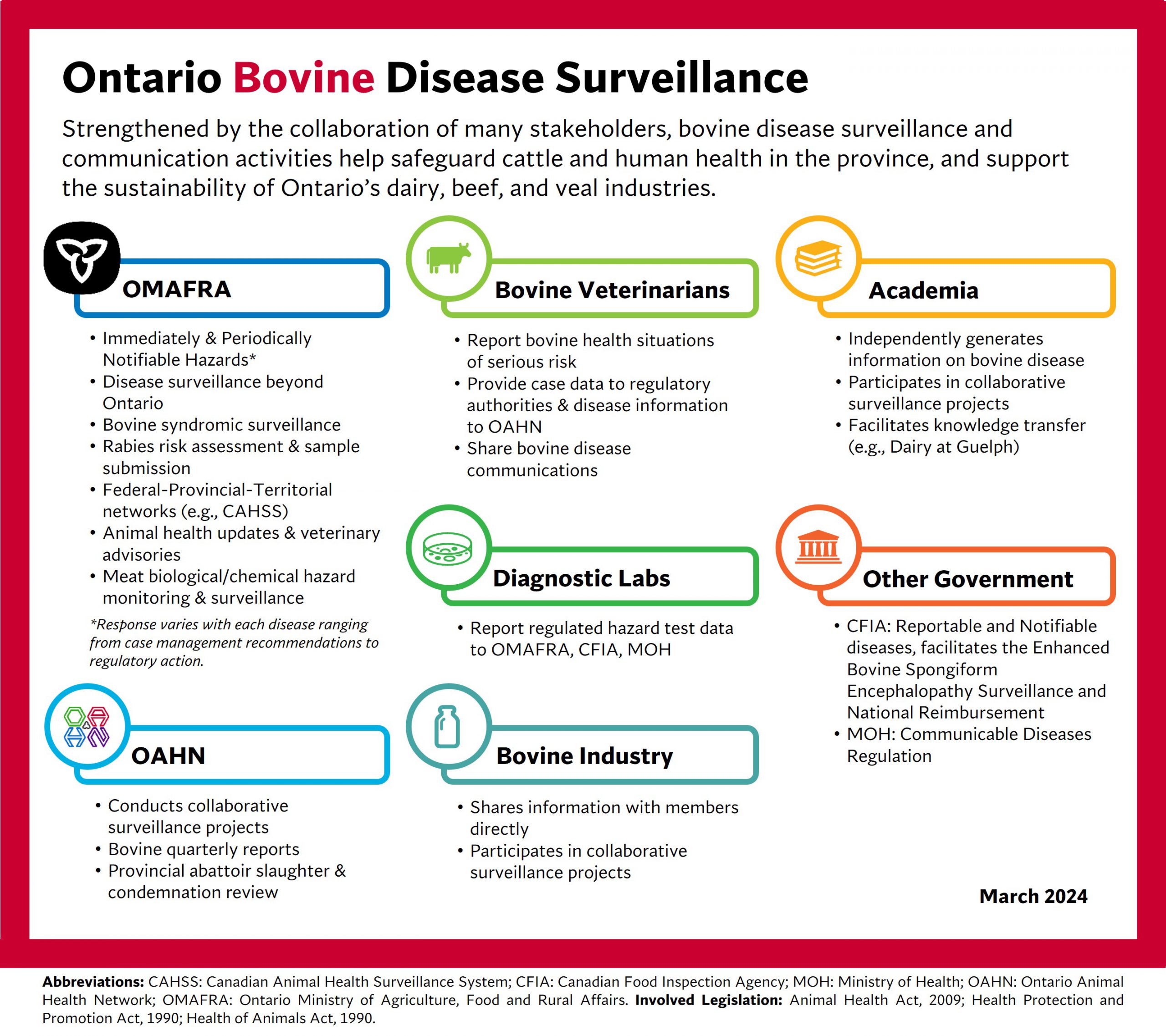 Bovine disease surveillance in Ontario is a collaborative effort involving many public and private stakeholders. Diagnostic results generated by veterinary laboratories, clinical impression and case data provided by bovine veterinarians, disease detections reported outside of Ontario, and research projects facilitated by Academic institutions or the Ontario Animal Health Network (OAHN), are all key sources of surveillance data. Strong communication between these stakeholders and with dairy, beef, and veal producers supports both cattle and human health in Ontario.
Bovine disease surveillance in Ontario is a collaborative effort involving many public and private stakeholders. Diagnostic results generated by veterinary laboratories, clinical impression and case data provided by bovine veterinarians, disease detections reported outside of Ontario, and research projects facilitated by Academic institutions or the Ontario Animal Health Network (OAHN), are all key sources of surveillance data. Strong communication between these stakeholders and with dairy, beef, and veal producers supports both cattle and human health in Ontario.
Please follow the links below for additional information on the associated activities or organizations and for many resources useful to bovine industry members.
OMAFRA
- Immediately & Periodically Notifiable Hazards*
- Disease surveillance beyond Ontario
- Bovine syndromic surveillance
- Rabies risk assessment & sample submission
- Federal-Provincial-Territorial networks (e.g., CAHSS)
- Animal health updates & veterinary advisories
- Meat biological/chemical hazard monitoring & surveillance
*Response varies with each disease ranging from case management recommendations to regulatory action.
OAHN
- Conducts collaborative surveillance projects
- Bovine quarterly reports
- Provincial abattoir slaughter & condemnation review
Bovine Veterinarians
- Report bovine health situations of serious risk
- Provide case data to regulatory authorities & disease information to OAHN
- Share bovine disease communications
Diagnostic Labs
Bovine Industry
- Shares information with members directly
- Participates in collaborative surveillance projects
Academia
- Independently generates information on bovine disease
- Participates in collaborative surveillance projects
- Facilitates knowledge transfer (e.g., Dairy at Guelph)
Other Government
- CFIA: Reportable and Notifiable diseases, facilitates the Enhanced Bovine Spongiform Encephalopathy Surveillance and National Reimbursement
- MOH: Communicable Diseases Regulation
Other Resources to Check Out
OAHN Bovine Network Research Project: Trace Mineral Status in Ontario Beef Herds Summary
OAHN Network Project: Identification of Culicoides species found in selected areas of Ontario from June – September 2022
Project page – OAHN Network Project: Identification of Culicoides species found in selected areas of Ontario from June – September 2022 – Ontario Animal Health Network
Help us help you!
Have an idea for an infographic you’d like to see, or a podcast you’d like to hear? Email oahn@uoguelph.ca to let us know!
2023
